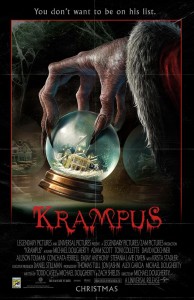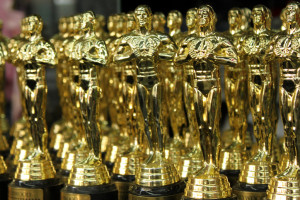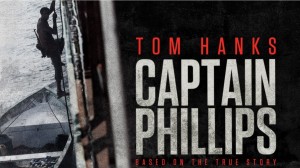On an unassuming night sometime late August I settled into my cinema seat ready to watch the previews for whatever mediocre movie I had found when I was struck with a tiny drop of film magic: Krampus. The preview promised some laughs, scares, Christmas glitter and grisly deaths. It also promised something I have been secretly dying to see for years- the revival of the Christmas horror genre.
 Finally after months of waiting, my sister, myself and a rag-tag gang of Houghtonites piled into the car and beheld the wonder. And Krampus pretty well held up to expectations, though I have a few notes.
Finally after months of waiting, my sister, myself and a rag-tag gang of Houghtonites piled into the car and beheld the wonder. And Krampus pretty well held up to expectations, though I have a few notes.
The general story is solid. In a very “National Lampoon” way an extended family crams together in one extremely nice suburban home to celebrate the holidays. Between a gentle german-speaking grandmother (Krista Stadler), a rough and tumble country crew (Allison Tolman, David Koechner), a persnickety angry dowager aunt (Conchata Ferrell) and the trying-to-hold-it-together matriarch (Toni Collette) and patriarch (Adam Scott) we have comedy gold. I was pleased to see that besides the proven comedy heavy-hitters of Ferrell, Koechner, Collette and Scott they were joined by the stoic genius of Tolman.
After some shenanigans and stress building the story’s protagonist, the young boy Max (Emjay Anthony), is fed up with his family’s constant bickering and tension and as a result revokes his belief is Santa Claus and instead accidentally summons the pagan god Krampus to wreak havoc on his home and community. What follows is complete terror as Krampus and his horde of demonic toy-creatures and elves descend on the snow-laden home.
While the story is indeed strong, it does lack some details. By this I mean we could really use a bit more on the history of this Krampus (who is, after all, an actual pagan Christmas god). There is a beautiful scene where Omi (the grandmother) tells her understanding of the entity and, while the story is interesting, we still could stand to understand the truly terrifying origins of the beast. Additionally the ending is somewhat weak. It is clear the writers hit a wall and ended up using a somewhat old horror trope to round things off. Without spoiling it I will say it’s not the worst…but it’s not the best.
However Krampus’s true strength certainly lies in the amazing mind of director Michael Dougherty. Dougherty has written for the horror genre for a while (among others Urban Legends: Bloody Mary) but only made his directing debut in 2007 with the instant Halloween classic Trick r’ Treat. His strengths in both Trick r’ Treat and Krampus are clear and lie in two places: creating 3-dimensional characters that you actually care about and providing the audience with some of the coolest creepy creatures you have ever seen. He is imaginative and unique and the results are beyond fabulous.
From killer gingerbread men to a monstrous snake-like jack-in-the-box that devours its victims whole, Dougherty gives the viewer part-organic, part-mechanic monsters, straight from the bowels of hell. Even Krampus is the perfect beautiful blend of terrifying and amazing that makes you squirm and never want to look away- a twisted dead-skinned, hoofed St. Nick with hollow eyes and a broken jaw sagging open to reveal his long serpentine tongue. All these creatures attack the family the audience has somehow been endeared to in just the 45 minutes they have spent watching. These two strengths alone turn a film with a few plot holes into a pretty solid horror flick and one I would certainly recommend to anyone who likes a good scare.
I think it is safe to safe that Michael Dougherty has officially set his mark on the horror world, I can’t wait to see what he presents us with next. In the meantime grab a candy cane and some popcorn and head to the theaters for some Frank Sinatra Christmas tunes and terrifying man-eating monsters. How festive, how cozy.






